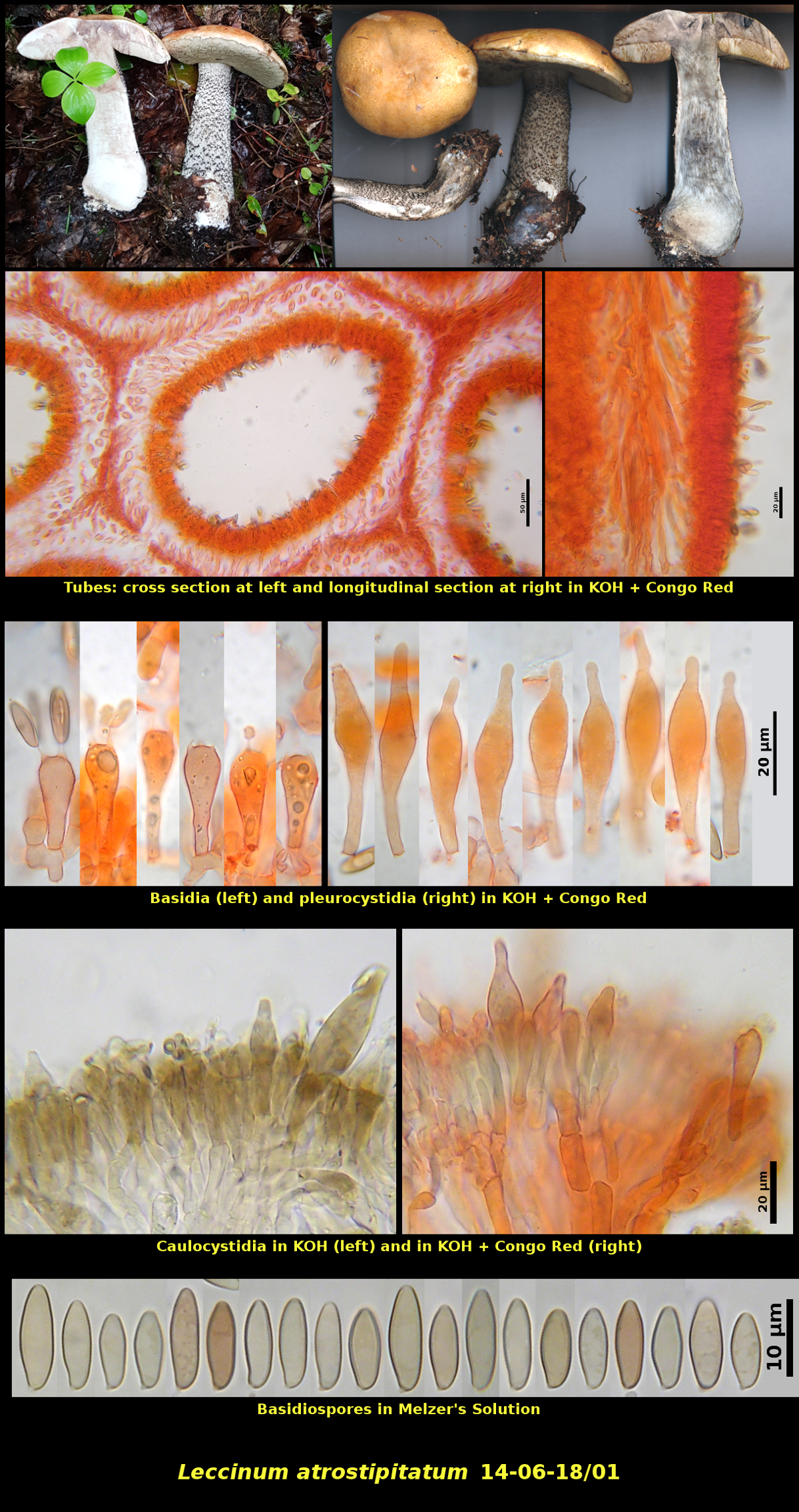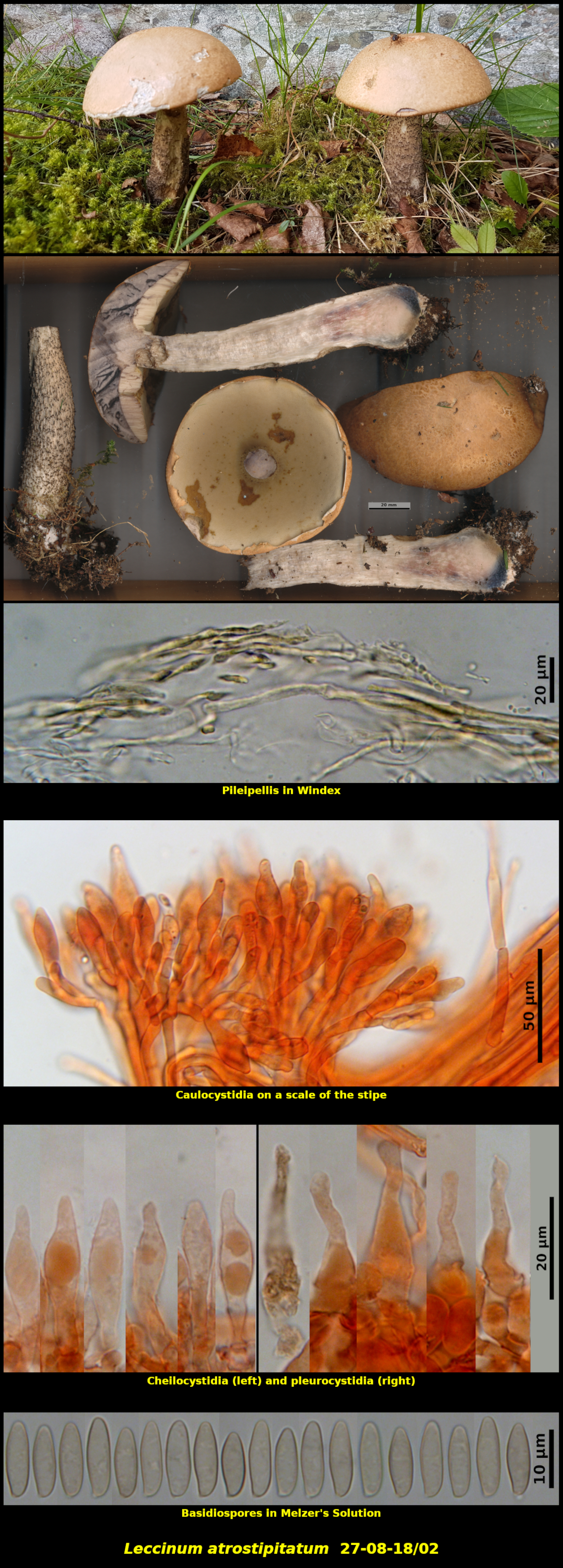Fleshy Fungi of New Brunswick >>
Leccinum atrostipitatum
Leccinum atrostipitatum A.H. Sm., Thiers & Watling


Two collections:
-
1. Scattered (2) in soil of old woods road under Betula papyrifera, Canoose Flowage Protected Natural Area, New Brunswick (14-06-18/01).
-
Pileus convex at first and expanding to more broadly so at maturity, dry, glabrous, very finely aereolately cracked in one, soft and smooth, light orange (HSV35:30-40:90-100), with a very slightly overhanging margin, 80-115 mm in diameter. Stipe clavate, densely covered with very dark brown to black scales, white below the scales, moist to dry, staining dark grey or green where bruised, 110-120 X 15-25 mm. Tubes very pale yellow (HSV50:05-10:100), adnexed, 10-11 mm thick, 3-4 per mm. Flesh white at first. turning light brown when cut and then turning nearly black in the cap and upper stipe, with some blue-green colours toward the base of the stipe, lacking a distinctive odour.
Basidiospores boletoid, smooth, variably dextrinoid in Melzer’s Solution to non-dextrinoid, 9.7-13.6 X 3.5-4.5 μm, D/d = 2.41-3.37 (average[30]: 11.4 X 3.9 μm, D/d = 2.92). Pleurocystidia abundant, ventricose to lageniform, stipitate. Caulocystidia forming the terminal cells of the stipe squamules, dark brown, similar to the pleurocystidia..
-
-
Pileus convex-hemispherical at first, expanding to more broadly so at maturity, with pileipellis overhanging the margin by 3-10 mm, dry, glabrous to minutely appressed-scaly, dull reddish orange (HSV40:20-30:100), 90-115 mm in diameter. Stipe equal to slightly clavate, densely covered with dark brown to nearly black scales, white below the scales, dry, 130-140 X 16-18 mm. Pores and tube mouths yellow (HSV50;20-30:100), darkening where bruised but otherwise not changing colour, small (about 3/mm), 7-10 mm long, adnexed. Flesh yellow (HSV5;03:100), in the pileus and stipe cortex, pale olivaceous in streaks in the interior of the stipe, with a nondescript mushroom odour, tasteless. On exposure to air the flesh of the pileus becomes dark grey to nearly black; the stipe becomes blackish grey near the summit but otherwise remains unchanged down the lower 1/3; the lower third of the stipe has a green colour (HSV 150:30:60-80) around the base and is purple red (HSV340;70:70-80) at the centre.
Basidiospores reddish brown (HSV10:30:80) in spore print, 11.0-15.9 x 3.8-4.3 μm, Q = 2.64-3.74, average[50]: 12.7 x 4.1 μm, Q = 3.12. Cheilocystidia forming a continuous sterile palisade, ventricose to lageniform, colourless, 27-36 x 6.5-7.8 μm. Pleurocystidia not reviving well in KOH or in Melzer’s Solution, scattered, abundant, lageniform, 28-40 x 6.4-11.9 μm. Basidia short-clavate, 4-spored, lacking a basal clamp connection. Pileipellis a thin cutis of yellow encrusted hyphae. Caulocystidia produced in fasicles and forming the dark scabers, hyaline to dark brown, ventricose to lageniform, with walls thin to slightly thickened, 27-51 x 6.0-15.0 μm. Clamp connections lacking on all septa.
2. Gregarious (3 – but one badly damaged and discarded) among mosses and leaves at the edge of a forest of Betula cordifolia and Abies balsamea, Little Lepreau, New Brunswick (27-08-18/02).
Leccinum atrostipitatum is a regular associate of birch, forming mycorrhizae with its roots. It is recognized by its orange-tan pileus and by its white stipe densely covered with dark brown to black squamules.
The basidiospores of Collection 14-06-18/01 are somewhat smaller than those usually reported in the literature. This discrepency is possibly due to the fact that this collection is not accompanied by a spore print, and as a result the measurements were taken from spores still attached to the insides of the tubes. Some of the spores at the low end of the measurement range may have been immature.